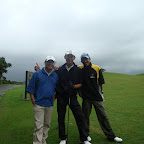 1 |
One of the most common mistakes amateurs make is improper alignment. Some think they should align their feet at the target, others try to get their shoulders parallel to it. Hey, some golfers try to align everything at the target! They’re all wrong.
The correct way to align your shots is to always begin by first assessing your target from behind the ball. This will give you a perspective of the entire hole and help you aim right where you want the ball to go. Secondly, before you make your actual stance, set the clubface behind the golf ball and align it directly at the target. Do this before, not after, you get into your stance. PGA Tour players have a knack for aligning the clubhead in this fashion. Pay attention to how they do it the next time you tune in.
 After you have the right clubface alignment, then comes time to situate the rest of your body. Most players benefit from aligning their lower body left of the target line and their upper body parallel to the target line. There’s actually no right answer as to what works best for you, but one thing is for sure. Aligning your body directly at the target rarely works. It usually leads to crossovers and over-the-top swings. Keep your body aiming left of the target line, and experiment with what works best for you. But be sure to align that clubface first!
After you have the right clubface alignment, then comes time to situate the rest of your body. Most players benefit from aligning their lower body left of the target line and their upper body parallel to the target line. There’s actually no right answer as to what works best for you, but one thing is for sure. Aligning your body directly at the target rarely works. It usually leads to crossovers and over-the-top swings. Keep your body aiming left of the target line, and experiment with what works best for you. But be sure to align that clubface first!  2 |
 |
TRICK 2: Choose The Right Club
Most amateurs choose what club to use based on length. On shorter holes, they use shorter clubs. Longer holes, longer clubs; and so on. But better players know there’s more to selecting the right club than that. It also includes things like natural shot tendencies, wind, hazards and whether or not hidden dangers lurk in prime landing areas. But most of all, a better player looks at what type of approach shot is to follow. The hole may be only 365 yards long, but with a good drive, that leaves a touchy 70- to 80-yard approach. Who wants that? The right play would be to avoid awkward distances and hit a 3-wood, leaving a full wedge approach.
Lastly, a better player acknowledges that a shot with a 3-wood has a greater likelihood of hitting the fairway than a driver shot does. And with today’s new groove rules, hitting the fairway has become more important than ever.
 3 |
 |
Instinctively, you might assume that the stance changes, depending on the club. Not true! When it comes to full shots (not pitches, chips or putts), maintaining a consistent stance is critical to becoming a better ballstriker.
That’s not to say there are minor adjustments in spine angle, ball position and stance width, but generally, how you stand over an iron should not be far off from how you situate yourself with a driver. Notice the similarities in the photos above? This is what you want.
 4 |
 |
Better players always, and I mean always, have a fundamentally solid grip. To start, grip the club with your gloved hand and emphasize the handle’s placement in the fingers between the first knuckle and the palm. Then, apply the ungloved hand so it wraps comfortably around the handle. From there, the thumb and index fingers of both hands form two Vs, both of which should be pointed somewhere around the right side of your chest or right shoulder. Follow this advice and you’ll have a solid grip.
 5 |
TRICK 5: Play With The Wind, Not Against It
Many amateurs fret about playing in the wind, but better players know how to use wind to their advantage. For instance, better players know that no matter what type of shot you’d normally play, whether it’s a draw, fade or whatever, how the wind blows changes everything. You have to make adjustments to make the wind work for you, instead of trying to hit a shot to fight against it. I’ve seen that happen time and time again with amateurs.
Put it this way, no matter how big a fade or draw you’re capable of hitting, it’s likely the wind will always win. So what do you do? Play with it! In the photo above, I’ve got a stiff wind blowing from right to left. Instead of battling it, I’ve opted to hit a drawing tee shot with hopes that the wind works alongside me to move the ball from right to left. Also, since I’m playing with the wind and not against it, it’s likely my draw will be more pronounced, so I need to make sure I aim farther right to allow for it. And by the way, if, by chance, my natural ballflight was a fade, instead of hitting a draw, I’d play for a straight shot and aim a little less right of the target. Either way, I’m letting the wind move the ball back into the fairway.
Still not convinced? Well, had I played a fade, I’d have run a greater risk of pulling the tee shot with the ball not fading enough or at all. And with that right-to-left wind, things would only get worse. I’d be hitting my second shot from the bear grass! If the wind were blowing the other way, a better player knows to never fight a slice wind. The play is to aim left and let the ball drift to the right back into the fairway.
Lastly, when playing in the wind, no matter which way it’s blowing, don’t think you need to swing any harder than normal. Just accept the fact that wind is blowing, and although it may be in an undesirable direction, the key is to avoid going to war with it. This will foul up your rhythm and tempo, not to mention your scorecard.

























































































